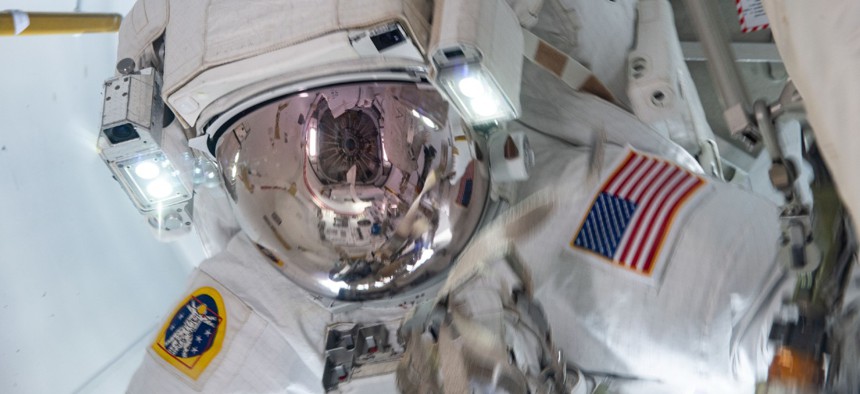
NASA spacewalker Shane Kimbrough is pictured in the U.S. Quest airlock after he and fellow spacewalker Thomas Pesquet of the European Space Agency completed the installation of the second roll out solar array on the International Space Station's Port-6 truss structure. NASA
NASA Ranks as the Best Place to Work in Government for Ninth Year
The federal government still has “a lot of work to do to improve its competitiveness with the private sector as an employer of choice,” head of the nonprofit that released the rankings says.
For the ninth year in a row, NASA came out as the best place to work in the federal government among large agencies in a nonprofit’s annual rankings.
On Tuesday, the nonprofit Partnership for Public Service and global management consulting firm Boston Consulting Group released the 2020 Best Places to Work in the Federal Government rankings, based largely on responses to the Office of Personnel Management's annual Federal Employee Viewpoint Survey that was administered from Sept. 14, 2020, to Nov. 5, 2020. The Partnership and consultancy incorporated additional survey data from 10 agencies (including the Veterans Affairs Department and Peace Corps) as well as responses from intelligence agency employees.
The top overall ranking went to the agency with the highest employee “engagement” score as determined by the Partnership and Boston Consulting based on the answers to three questions on job satisfaction, satisfaction with the organization more broadly and whether the employee would recommend his or her agency as a good place to work.
Governmentwide, federal employee engagement was 69 out of a possible score of 100, which fell short of the private sector’s engagement rating of 77 (from the employee research firm Mercer).
While these were the same questions asked last year, the Partnership said that this year’s scores can’t be compared to previous years due to changes in the 2020 FEVS and the Partnership’s method for calculation. However, using a “recalculation of our 2019 score using new methodology adopted this year,” the Partnership found there was about “a 3.9-point increase from 2019” in the governmentwide engagement score.
The highest ranked agencies for 2020 in terms of overall engagement were: NASA (among large agencies), the Government Accountability Office (among mid-size agencies), the Congressional Budget Office (among small agencies) and the Tennessee Valley Authority’s Office of Inspector General (among subcomponent agencies).
The rankings also found that only 22 of the 71 large, mid-size and small agencies included in the rankings scored above the private sector’s score this year.
“The 2020 data makes clear that the federal government still has a lot of work to do to improve its competitiveness with the private sector as an employer of choice,” said Max Stier, president and CEO of the Partnership, in a statement. “The government must strive to meet or exceed the private sector when it comes to employee engagement.”
Meanwhile, 84.1% of federal employees said the people they work with cooperate to accomplish their jobs compared to 78% in the private sector, and 67% of federal employees said they were satisfied with their pay compared to 54% in the private sector, according to the results.
Agencies that “lost ground” from 2019 to 2020 were: the Health and Human Services Department (went from second to fourth in the large agency category); the U.S. Agency for International Development (went from 14th to 19th in the mid-size category); the Office of Management and Budget (went from sixth to 29th among small agencies) and Citizenship and Immigration Services (went from the top 25% among agency subcomponents to the bottom 25%).
Another takeaway from this year's results was that the National Institutes of Health and the Centers for Disease Control and Prevention––both agencies on the frontlines of combatting the coronavirus pandemic–– “had vastly different employee experiences in 2020,” said the Partnership. “NIH remained steady in the rankings, recording a Best Places to Work score of 81.7 out of 100 and placing 63 out of 411 agency subcomponents. The CDC had a score of 72.4, dropping from 81 in the 2019 rankings to 192 in 2020.” (While scores from previous years cannot be compared, it is fine to compare agency rankings, according to the Partnership).
The Partnership and consultancy also found that during the height of the pandemic, 59% of the federal employee respondents said they were teleworking every day, compared to only 3% before. About 78% of the respondents reported they were satisfied with their agency’s telework program.
The top five agencies within each of the four categories will be honored during a virtual ceremony on Tuesday morning that will feature several Cabinet secretaries.
“The 2020 Best Places to Work data paints a picture of agencies that demonstrated agility and found creative ways for employees to successfully deliver on their missions in mostly remote settings while giving them the flexibility to meet their personal needs,” Stier said. “This experience provides a unique opportunity for President Joe Biden and his administration to build on the lessons of the past year by placing a heightened focus on engaging employees and by addressing their workplace concerns, critical factors necessary for a well-functioning government.”







